In what could be a first in a series of historical pilgrimages, we were toured around Binondo and Sn. Nicolas Manila by the great Filipino artist-historian, future artista nacional, Señor Gomez Rivera. With his astonishing grasp and familiarity of the locale, he took this two (Pepito y yo) tyro chroniclers into the begrimed esquinitas of Binondo and the crumbly old Spanish era houses of Sn. Nicolas, telling tales and legends of what was once the beautiful arrabales of old Spanish Manila.
One street, concealed, dark and filthy, was where the house of Pepe Rizal's relatives once stood, no marker just some new shops selling stuff (the products you see labeled in Mandarin) and a horde of beggars asking for some change. Here was Don Francisco Mercado final stop before joining his popular hero son in the afterlife. He died in this place, he lived a silentious life, he was the typical Chinese Filipino, he was frugal, cautious always and was a devoted family man. It was (the Mercado residence), according to Señor Gomez, a small house compared to the other rich casa's "pero elegante", and so is the streets where this casas stood. Now, this gutterless, cramped street - this part of Calle Estraude is but a shadow of what was once an alluring little mestizaje neighbourhood with a living small estero for a view (now, I think if ever you fall in that estero you'll die, not from drowning but because of its mephitic water!).
[caption id="" align="alignnone" width="240" caption="Calle Estraude (Don Francisco's house once stood here)"]
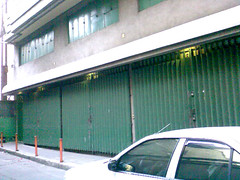 [/caption]
[/caption]This awful looking buildings are testament of what can be referred to as the districts progressive transformation, from the old Binondo town to the new town (literally ‘new' because the old houses are being phased out!). Economics often times dictate what would become of a locality, its future is always tied to its commerce. A rustic Macati then is a financial city now, with all its skyscrappers hoovering up above, a farm, a hill could become a residential villa. At this rate (accelerating phase as can be observe this past decades), we are losing more and more of this heritage sites. Once we lost them, we lost them forever - this we have to remember. Is this really progress?
Another building left to decay is the celebrated Hogar Filipino. This hotel was the loftiest structure in the 30's, arguably the finest concrete building created by its generation, in that legendary street called Anloague. The wedding gift (yes, it was for a Zobel daughter) hosted foreign dignitaries and notable personage. It was spacious, elegant and yes, a very expensive place to spend the night in! but like many structures after the war, it was neglected. Prestige drifted away from this part of the town (partly due to poor city management & planning) so in this once graceful belt, whose edge tips the river Pasig, whose fresh water joins the sea, died, not too long ago. It can be revived - how? this is the challenge for this new Manileño generation.
[caption id="" align="alignnone" width="240" caption="Hogar Filipino"]
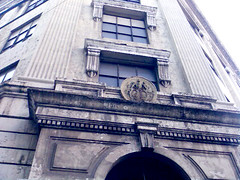 [/caption]
[/caption]And the list goes on.
As we were driving around Binondo, we came into a screeching halt, I thougth that we ended up in a jeep terminal, then my passengers reminded me that Luna St. usually are like this. So you'll just have to drive around the jam. Good thing was its Sunday, so taking direction from Señor Gomez, circling some esquinitas, with some twist and turn he brought us to Urbiztondo, the Antonio Luna birthplace.
Unlike the sad fate of that Estraude home of the Rizal's, The tagailog's place of birth was intact. Thank God. Its fronting the institution named after that prehispanic hero Rajah Solaiman. The abode's fascade at least is preserved with some marks of decay, it was decorated by some banners and small flags commemorating its famous son Antonio's birthday. Since no one can go in, one could only wonder what's inside. It was an elegant, noble house, one thing that you can say about this old casas of Binondo and San Nicolas is that, although their confined in space due to the population of the district (compared to the bahay na bato in the countryside), they never forgot about style, they were western in their sophistication and taste! architecture was detailed from the wide windows, classy iron grills, chic doors, genteel roof - Ah, I think they heard William Morris, that British Socialist and Poet (1834-1896), when he said "have nothing in your house that you do not know to be useful, or believe to be useful".
[caption id="" align="alignnone" width="240" caption="Luna Residence"]
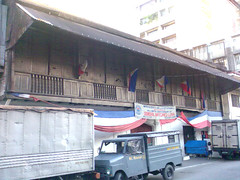 [/caption]
[/caption]Exiting Urbiztondo heading straight towards San Nicolas all of the old casa are lined up. like pretty maids all in a row -- the Sunico house, built on Calle Barcelona corner Jabonero, is now deserted but a closer look would show how this propertied families built their houses. From its wide windows, one could see all the way to Intramuros. Down to the very last piece in this disintegrating houses is art. Right across the Sunico's, another old house went down. (Nalungkot talaga ako), it broke my heart seeing something so beautiful destroyed. Some excavation was taking place already, looks like a high rise project - century old adobe bricks and lumber being scrapped. We all look and felt funereal, standing there and seeing those people hammer away, are they even aware what their doing? In this town, its just another old house, but for Manila another piece of history ditched.
[caption id="" align="alignnone" width="240" caption="Sunico house"]
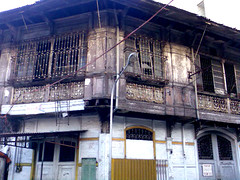 [/caption]
[/caption]The Casa Vizantina (I already featured this here), arguably the grandest of all the San Nicolas houses, three storey high extended for almost a block. It currently it holds a sizeable squatting community inside. Now, considered a dangerous structure, it was once a hotel and an institute (Instituto Manila, now UM). This marvel of Filipino architecture is headed to the slaughterhouse, there are already plans to tear it down. Same story here.
The Pio Valenzuela house was next, thank God it has a marker, I hope no ones pissing on it becaue its placed in a corner and its just a feet from the ground. The NHI marker was Installed commemorating what was the house of a hero and the site where the revolutionary paper, "Kalayaan" was printed. Pio figured popularly in the life of Rizal and the revolution for it was him who announced that the national hero denouced the revolution, much to the dismay of Boni, he did however, had another version after the war ended, this time he claims that the Calambeño was supporting the movement.
[caption id="" align="alignnone" width="240" caption="Pio Valenzuela's residence where the Kalayaan was printed"]
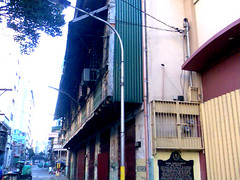 [/caption]
[/caption][caption id="" align="alignnone" width="240" caption="Rogelio de la Rosa once was here!"]
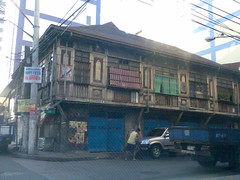 [/caption]
[/caption]Just before we head out we dropped by what was once Rogelio de la Rosa's house, the matinee idol live in San Nicolas with his wife Lolita Bayot. He raised his son, Rogelio II in that old house in Calle Lara. The Señor claims that Rogelio was not proficient in Castillian and that his lines are often dubbed. This Kababayan of the Macapagals would become a senador under the Partido Liberal. He could be considered the Father of Showbiz turned politicos, his bid for the presidency was not successful. He was assaigned ambassador to various countries.
Every inch of Binondo and San Nicolas has a story to tell, Some streets are no more (a Calle Nueva is now renamed Yuchengco), old houses are slowly diminishing (this year we witnessed several houses taken down) - their like those endangered animals, if not conserved, without planning and vision, they would become extinct. "There was once a house there..." - the Señor would tell us, this line would soon become ours, as we tell the sad fate of this houses.



El gran escritor español Vicente Blasco Ibáñez se registró en Hogar Filipina durante su visita corta a nuestro país en la década 20. Y él hasta dió un discurso a los escritores filipinos en Philippine Normal School (ahora conocido como Philippine Normal University.
ReplyDeleteSi queréis leer lo que escribió Blasco Ibáñez de su vista a Manila, lo encontraréis en este link:
ReplyDeletehttp://www.cervantesvirtual.com/servlet/SirveObras/01349497544359072979680/ima0200.htm
Gracias Sr. Manolo.
ReplyDeleteI was there in Cervantes the other day, no one told me that clearance for certificates (nivel 1 y 2) are only given from 4 to 5. I was there from 12 noon, well, if it was any consolation, I read for hours there in our very beautiful library! ^_^
el lugar es una 'area' muy buena para el aprendizaje. su haciendo un buen trabajo Sr. Manolo.